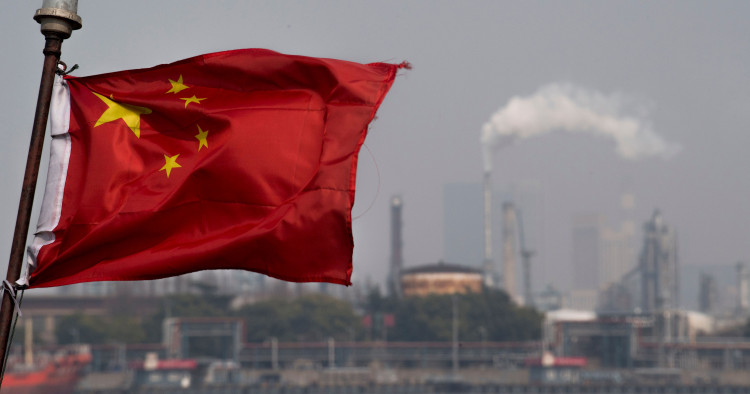This piece is part of the series “All About China”—a journey into the history and diverse culture of China through short articles that shed light on the lasting imprint of China’s past encounters with the Islamic world as well as an exploration of the increasingly vibrant and complex dynamics of contemporary Sino-Middle Eastern relations. Read more ...
This year, China is expected to overtake the United States as the world’s largest oil refining country.[1] Although China’s bloated and fragmented crude oil refining sector has undergone major changes over the past decade, it remains saddled with overcapacity.[2]
Privately owned unaffiliated refineries, known as “teapots,”[3] mainly clustered in Shandong province, have been at the center of Beijing’s longtime struggle to rein in surplus refining capacity and, more recently, to cut carbon emissions. A year ago, Beijing launched its latest attempt to shutter outdated and inefficient teapots — an effort that coincides with the emergence of a new generation of independent players that are building and operating fully integrated mega-petrochemical complexes.[4]
The changing roles played by China’s independent refineries are reflected in their relations with Middle East suppliers. In the battle to ensure their profitability and very survival, smaller Chinese teapots have adopted various measures, including sopping up steeply discounted oil from Iran. Meanwhile, Middle East suppliers, notably Saudi Aramco, are seeking to lock in Chinese crude demand while pursuing new opportunities for further investments in integrated downstream projects led by both private and state-owned companies.
China’s “Teapot” Refineries
China’s “teapot” refineries[5] play a significant role in refining oil and account for a fifth of Chinese crude imports.[6] Historically, teapots conducted most of their business with China’s major state-owned companies, buying crude oil from and selling much of their output to them after processing it into gasoline and diesel. Though operating in the shadows of China’s giant national oil companies (NOCs),[7] teapots served as valuable swing producers — their surplus capacity called on in times of tight markets.
Yet, the Chinese government has spent the better part of two decades trying to consolidate the country’s sprawling independent refining sector by starving private operators of access to imported crude oil and targeting the smallest, least efficient plants for closure.[8] In 2011, China’s National Development and Reform Commission (NDRC) issued guidelines to eliminate small refineries to achieve economies of scale and improve efficiencies. Nevertheless, policies meant to discourage activity had the opposite effect, as most of the units that were earmarked for suspension expanded to stay open.[9]
Four years later, the NDRC adopted a different approach, awarding licenses and quotas to teapot refiners to import crude oil and granting approval to export refined products in exchange for reducing excess capacity, either upgrading or removing outdated facilities, and building oil storage facilities.[10] But this partial liberalization of the refining sector did not go exactly according to plan. Swelling with new sources of feedstock that catapulted China into the position of the world’s largest oil importer, teapots increased their production of refined fuels and, benefiting from greater processing flexibility and low labor costs undercut larger state rivals and doubled their market share.[11]
Meanwhile, as teapots expanded their operations, they took on massive debt, flouted environmental rules, and exploited taxation loopholes.[12] Of the refineries that managed to meet targets to cut capacity, some did so by double counting or reporting reductions in units that had been idled.[13] And when, reversing course, Beijing revoked the export quotas allotted to teapots and mandated that products be sold via state-owned companies, it trapped their output in China, contributing to the domestic fuel glut.
2021 marked the start of the central government’s latest effort to consolidate and tighten supervision over the refining sector and to cap China’s overall refining capacity.[14] Besides imposing a hefty tax on imports of blending fuels, Beijing has instituted stricter tax and environmental enforcement[15] measures including: performing refinery audits and inspections;[16] conducting investigations of alleged irregular activities such as tax evasion and illegal resale of crude oil imports;[17] and imposing tighter quotas for oil product exports as China’s decarbonization efforts advance.[18]
Last October, Beijing reduced crude oil import quotas awarded to small independent refineries for the first time since they were allowed into the market while raising them for larger, more efficient private plants. Among the primary beneficiaries of these new allocations are a new generation of provincial-backed independent players long interested in expanding into the oil refining business.[19]
The politics surrounding this new class of greenfield mega-refineries is important, as is their geographical distribution. Beijing’s reform strategy is focused on reducing the country’s petrochemical imports and growing its high value-added chemical business while capping crude processing capacity. The push by Beijing in this direction has been conducive to the development of privately-led mega refining and petrochemical projects, which local officials have welcomed and staunchly supported.[20]
Yet, of the three most recent major additions to China’s greenfield refinery landscape, none are in Shandong province, home to a little over half the country’s independent refining capacity. Hengli’s Changxing integrated petrochemical complex is situated in Liaoning, Zhejiang’s (ZPC) Zhoushan facility in Zhejiang, and Shenghong’s Lianyungang plant in Jiangsu.[21]
As China’s independent oil refining hub, Shandong is the bellwether for the rationalization of the country’s refinery sector. Over the years, Shandong’s teapots benefited from favorable policies such as access to cheap land and support from a local government that grew reliant on the industry for jobs and contributions to economic growth.[22] For this reason, Shandong officials had resisted strictly implementing Beijing’s directives to cull teapot refiners and turned a blind eye to practices that ensured their survival.
But with the start-up of advanced liquids-to-chemicals complexes in neighboring provinces, Shandong’s competitiveness has diminished.[23] And with pressure mounting to find new drivers for the provincial economy, Shandong officials have put in play a plan aimed at shuttering smaller capacity plants and thus clearing the way for a large-scale private sector-led refining and petrochemical complex on Yulong Island, whose construction is well underway.[24] They have also been developing compensation and worker relocation packages to cushion the impact of planned plant closures, while obtaining letters of guarantee from independent refiners pledging that they will neither resell their crude import quotas nor try to purchase such allocations.[25]
To be sure, the number of Shandong’s independent refiners is shrinking and their composition within the province and across the country is changing — with some smaller-scale units facing closure and others (e.g., Shandong Haike Group, Shandong Shouguang Luqing Petrochemical Corp, and Shandong Chambroad Group) pursuing efforts to diversify their sources of revenue by moving up the value chain. But make no mistake: China’s teapots still account for a third of China’s total refining capacity and a fifth of the country’s crude oil imports. They continue to employ creative defensive measures in the face of government and market pressures, have partnered with state-owned companies, and are deeply integrated with crucial industries downstream.[26] They are consummate survivors in a key sector that continues to evolve — and they remain too important to be driven out of the domestic market or allowed to fail.
Under the Radar: Chinese Teapot Refiners and Middle East Producers
The changing structure and dynamics of China’s refining sector, specifically with respect to Chinese teapots, has impacted energy relations with Middle East producers. Indeed, Chinese teapot refiners, which just a few years ago arose as attractive crude oil spot market targets, have lately emerged as outlets for longer-term crude exports from the region.
In 2016, during the period of frenzied post-licensing crude oil importing by Chinese independents, Saudi Arabia began targeting teapots on the spot market, as did Kuwait. Iran also joined the fray, with the National Iranian Oil Company (NIOC) operating through an independent trader Trafigura to sell cargoes to Chinese independents.[27] Since then, the coming online of major new greenfield refineries such as Rongsheng ZPC and Hengli Changxing, and Shenghong, which are designed to operate using medium-sour crude, have led Middle East producers to pursue long-term supply contracts with private Chinese refiners. In 2021, the combined share of crude shipments from Saudi Arabia, UAE, Oman, and Kuwait to China’s independent refiners accounted for 32.5%, an increase of more than 8% over the previous year.[28] This is a trend that Beijing seems intent on supporting, as some bigger, more sophisticated private refiners whose business strategy aligns with President Xi’s vision have started to receive tax benefits or permissions to import larger volumes of crude directly from major producers such as Saudi Arabia.[29]
The shift in Saudi Aramco’s market strategy to focus on customer diversification has paid off in the form of valuable supply relationships with Chinese independents. And Aramco’s efforts to expand its presence in the Chinese refining market and lock in demand have dovetailed neatly with the development of China’s new greenfield refineries.[30] Over the past several years, Aramco has collaborated with both state-owned and independent refiners to develop integrated liquids-to-chemicals complexes in China. In 2018, following on the heels of an oil supply agreement, Aramco purchased a 9% stake in ZPC’s Zhoushan integrated refinery. In March of this year, Saudi Aramco and its joint venture partners, NORINCO Group and Panjin Sincen, made a final investment decision (FID) to develop a major liquids-to-chemicals facility in northeast China.[31] Also in March, Aramco and state-owned Sinopec agreed to conduct a feasibility study aimed at assessing capacity expansion of the Fujian Refining and Petrochemical Co. Ltd.’s integrated refining and chemical production complex.[32]
Commenting on the rationale for these undertakings, Mohammed Al Qahtani, Aramco’s Senior Vice-President of Downstream, stated: “China is a cornerstone of our downstream expansion strategy in Asia and an increasingly significant driver of global chemical demand.”[33] But what Al Qahtani did not say is that the ties forged between Aramco and Chinese leading teapots (e.g., Shandong Chambroad Petrochemicals) and new liquids-to-chemicals complexes have been instrumental in Saudi Arabia regaining its position as China’s top crude oil supplier in the battle for market share with Russia.[34] Just a few short years ago, independents’ crude purchases had helped Russia gain market share at the expense of Saudi Arabia, accelerating the two exporters’ diverging fortunes in China. In fact, between 2010 and 2015, independent refiners’ imports of Eastern Siberia Pacific Ocean (ESPO) blend accounted for 92% of the growth in Russian crude deliveries to China.[35] But since then, China’s new generation of independents have played a significant role in Saudi Arabia clawing back market share and, with Beijing’s assent, have fortified their supply relationship with the Kingdom.
Smaller Chinese independents have been less fortunate, hit hard not just by tougher domestic regulation but by soaring crude oil prices.[36] US-led sanctions flowing from the war in Ukraine have compounded the pressure on teapots, which prior to the conflict had sourced about a fifth of their crude oil from Russia. Soaring oil tanker freight rates and the refusal of Chinese banks to issue letters of credit for Russian crude have choked off much of this supply, though some private refiners have compensated by using cash transfers to pay for Russian ESPO blend crude.[37]
Meanwhile, though, enticed by discounted prices Chinese independents in Shandong province have continued to scoop up sanctioned Iranian oil, especially as their domestic refining margins have thinned due to tight regulatory scrutiny. In fact, throughout the period in which Iran has been under nuclear-related sanctions, Chinese teapots have been a key outlet for Iranian oil, which they reportedly unload from reflagged vessels representing themselves as selling oil from Oman and Malaysia.[38] China Concord Petroleum Company (CCPC), a Chinese logistics firm, remained a pivotal player in the supply of sanctioned oil from Iran, even after it was blacklisted by Washington in 2019.[39] Although Chinese state refiners shun Iranian oil, at least publicly, because of US sanctions, private refiners have never stopped buying Iranian crude.[40] And in recent months, teapots have been at the forefront of the Chinese surge in crude oil imports from Iran.[41]
Conclusion
China’s small-scale, inefficient “first generation” teapot refiners have come under mounting market pressure, as well as closer government scrutiny and tightened regulation. Though some have already been shuttered and others face imminent closure, dozens of China’s teapots, concentrated mainly in Shandong province, continue to operate thanks to the creative defensive measures they have employed and the important role they play in local economies.
Vertical integration along the value chain has become a global trend in the petrochemical industry, specifically in refining and chemical operations. China’s drive to self-sufficiency in chemicals is a key factor powering this worldwide trend.[42] And it is the emergent “second generation” of independent refiners that it is helping make China the frontrunner in developing massive liquids-to-chemicals complexes. Following Beijing’s lead, Shandong officials appear determined to follow this trend rather than risk being left in its wake.
As Chinese private refiners’ number, size, and level of sophistication has changed, so too have their roles not just in the domestic petroleum market but in their relations with Middle East suppliers. Beijing’s import licensing and quota policies have enabled some teapot refiners to maintain profitability and others to thrive by sourcing crude oil from the Middle East. For their part, Gulf producers have found Chinese teapots to be valuable customers in the spot market in the battle for market share and, especially in the case of Aramco, in the effort to capture the growth of the Chinese domestic petrochemicals market as it expands.
[1] Oceana Zhou and Kshitiz Goliya, “China to surpass US as world’s top refiner in 2022 with 18.8 mil b/d capacity: ETRI,” S&P Global, April 14, 2022, https://www.spglobal.com/commodityinsights/en/market-insights/latest-news/oil/041422-china-to-surpass-us-as-worlds-top-refiner-in-2022-with-188-mil-bd-capacity-etri.
[2] Si-Yuan Chen et al., “Review on the petroleum market in China: history, challenges and prospects,” Petroleum Science 17 (2020): 1779-1794.
[3] These refineries are known as “teapots” because of the shape of early designs. They grew from small clay kilns that began processing oil from fields in Shandong that produced more than state refiners could absorb.
[4] “China’s New Oil Giants Flourish in Xi’s Clean Energy Wave,” Bloomberg, August 9, 2021, https://www.bloomberg.com/news/articles/2021-08-09/china-s-new-oil-giants-flourish-in-xi-s-clean-energy-wave.
[5] Teapots can also be found in Liaoning and Zhejiang provinces.
[6] “China’s independent refiners eye output cuts as crude price surge hurts profits,” Hellenic Shipping News, March 11, 2022, https://www.hellenicshippingnews.com/chinas-independent-refiners-eye-output-cuts-as-crude-price-surge-hurts-profits/.
[7] China Petroleum & Chemical Corporation (SINOPEC), China National Petroleum Corporation (CNPC), and the China National Offshore Oil Corporation (CNOOC).
[8] Erica Downs, “The Rise of China’s Independent Refineries,” Columbia | SIPA Center on Global Energy Policy (September 2017), https://energypolicy.columbia.edu/sites/default/files/CGEPTheRiseofChinasIndependentRefineries917.pdf.
[9] E. Shailaja Nair, “China’s teapot refiners expand to stay operational,” S&P Global, November 1, 2013, https://www.spglobal.com/commodityinsights/en/market-insights/latest-news/oil/110113-chinas-teapot-refiners-expand-aggressively-to-stay-operational.
[10] The new policy, though primarily aimed at spurring consolidation within China’s independent refining sector, was also intended to expose NOCs to more competition, as well as to compensate for a global price downturn and an anti-corruption purge that had lowered production from state-owned oilfields. See US Energy Information Agency (EIA), “Country Analysis Executive Summary: China,” September 30, 2020, https://www.eia.gov/international/content/analysis/countries_long/China/china.pdf.
[11] Riyuta Minamihata, “‘Teapot’ oil refinery consolidation in China may spawn a tempest,” Nikkei Asia, October 15, 2017, https://asia.nikkei.com/Business/Markets/Commodities/Teapot-oil-refinery-consolidation-in-China-may-spawn-a-tempest; Lucy Hornby, “China’s ‘teapot’ oil refineries pose challenge to majors,” Financial Times, April 7, 2016, https://www.ft.com/content/7fc95106-fc71-11e5-b5f5-070dca6d0a0d.
[12] Easwaran Kanason, “Trouble in the Teapot Oil Refining Industry,” NrgEdge, August 25, 2021, https://www.nrgedge.net/article/1629895898-trouble-in-the-teapot-oil-refining-industry.
[13] In 2015, China’s National Development and Reform Commission (NDRC) issued the “Notice on Issues Concerning the Administration of the Use of Imported Crude Oil,” which allowed qualified private enterprises to eliminate outdated production capacity in exchange for quotas for the use of imported crude oil. See Downs, “The Rise of China’s Independent Refineries;” and “Oil Refiners Struck by Glut Find Comfort in China Teapot Drought,” BloombergQuint, July 27, 2016, https://www.bloombergquint.com/china/oil-refiners-struck-by-glut-find-comfort-in-china-teapot-drought.
[14] Alfred Cang, “China Clamps Down on Private Oil Refineries to Curb Capacity,” Bloomberg, April 13, 2021, https://www.bloomberg.com/news/articles/2021-04-13/china-clamps-down-on-independent-oil-refiners-to-curb-capacity.
[15] Alfred Cang, Serene Cheong, and Sherry Su, “In Fight for Survival, China's Dimming Oil Stars Pledge to Unite,” Bloomberg, September 25, 2018, https://www.bloomberg.com/news/articles/2018-09-25/in-fight-for-survival-china-s-dimming-oil-stars-pledge-to-unite.
[16] “NDRC sets up working group to inspect independent refineries,” JLC Energy, April 12, 2021, https://mp.weixin.qq.com/s/YiGmmb42iXJqFw0fuAcxGQ.
[17] Shu Zhang and Muyu Xu, “China cuts second batch of crude oil import quotas for private refiners - document, sources,” Reuters, June 21, 2021, https://www.reuters.com/business/energy/china-cuts-2nd-batch-crude-oil-import-quotas-private-refiners-document-sources-2021-06-21/; Alfred Cang, “China Clamps Down on Private Oil Refineries to Curb Capacity,” Bloomberg, April 13, 2021, https://www.bloomberg.com/news/articles/2021-04-13/china-clamps-down-on-independent-oil-refiners-to-curb-capacity; “China Takes Aim at a Booming $7 Billion Market for Dirty Oil,” Bloomberg, March 17, 2021, https://www.bloomberg.com/news/articles/2021-03-17/china-takes-aim-at-a-booming-7-billion-market-for-dirty-oil; “China found three independent oil refiners evaded fuel tax,” Hydrocarbon Processing, January 20, 2022, https://www.hydrocarbonprocessing.com/news/2022/01/china-found-three-independent-oil-refiners-evaded-fuel-tax; and “China’s Oil Boomtown Braces for Crackdown From Beijing,” Bloomberg, June 17, 2021, https://www.bloomberg.com/news/articles/2021-06-17/china-intensifies-oil-refining-probe-that-could-upend-industry.
[18] Oceana Zhu, Surhabi Sahu, and Kshitiz Goliya, “CHINA DATA: 2021 oil products exports drop 12%, more cuts loom,” S&P Global, January 18, 2022, https://www.spglobal.com/commodityinsights/en/market-insights/latest-news/oil/011822-china-data-2021-oil-products-exports-drop-12-more-cuts-loom.
[19] Li Ling, How is the overcapacity in refining caused?” China Energy News, March 14, 2021, https://mp.weixin.qq.com/s/IIE8PJGeHu_UkVTJ7Z0y-g.
[20] “The China Connection – New petrochemical: Impactful or disruptive?” Argus, February 11, 2020, https://www.argusmedia.com/en/blog/2019/december/3/the-china-connection-new-petrochemical-refineries-impactful-or-disruptive.
[21] “China cuts crude oil import quota and favors mega-refiners,” Energy Voice, December 12, 2021, https://www.energyvoice.com/oilandgas/asia/376566/china-cuts-crude-oil-import-quota-and-favors-mega-refiners/; and Daisy Xu, Oceana Zhou, and Eric Yep, “Spotlight on Shandong: New petchem complexes threaten China’s oldest refining cluster,” S&P Global, October 21, 2019, https://www.spglobal.com/commodityinsights/en/market-insights/latest-news/oil/102119-china-oil-refineries-shandong.
[22] Meng Meng and Chen Aizhu, “From hinterland to wonderland: China’s ‘teapot’ refinery boomtowns,” AG Week, May 25, 2016, https://www.agweek.com/news/from-hinterland-to-wonderland-chinas-teapot-refinery-boomtowns.
[23] Chen Aizhu, “Exclusive: China approves $20 billion mega petchem complex in Shandong oil hub – sources,” Reuters, June 2, 2020, https://www.reuters.com/article/us-china-oil-refinery-shandong-exclusive-idUSKBN2390OU.
[24] “China starts building $20 billion mega petchem complex in Shandong oil hub: media,” Reuters, October 28, 2020, https://www.reuters.com/article/us-china-petrochemical-shandong-idUKKBN27D14A; Chen Aizhu and Muyu Xu, “China to cut teapot refining capacity as plans for mega complex,” Reuters, June 9, 2020, https://www.reuters.com/article/us-china-oil-refineries-closures/china-to-cut-teapot-refining-capacity-as-plans-for-mega-complex-idUSKBN23G0Z9; and “China to Shutter Teapot Refineries for Upcoming Mega Complex,” Globalenergyinfrastructure.com, November 11, 2021, https://globalenergyinfrastructure.com/articles/2021/11-november/china-to-shutter-teapot-refineries-for-upcoming-mega-complex/.
[25] Chen Aizhu ad Florence Tan, “China’s teapot refining hub seeks to stop crude quota trading,” Reuters, August 4, 2021, https://www.reuters.com/article/china-oil-quotas-teapots/chinas-teapot-refining-hub-seeks-to-stop-crude-quota-trading-idUSL4N2PB15K.
[26] Kanason, “Trouble in the Teapot Oil Refining Industry;” Hornby, “China’s ‘teapot’ oil refineries pose challenge to majors; Chen Aizhu, “China’s teapot plants form new club to beat rivals, but will it work?” Reuters, September 8, 2017, https://www.reuters.com/article/china-oil-refineries/chinas-teapot-plants-form-new-club-to-beat-rivals-but-will-it-work-idUKL4N1LM2FZ; and “China ‘teapot’ oil group urges compliance on quotas, tax,” Reuters, June 6, 2017, https://www.reuters.com/article/us-china-oil-independents-idUSKBN18X0GY.
[27] Chen Aizhu and Florence Tan, “Iran targets oil sales to China teapots via Trafigura: sources,” Reuters, July 18, 2016, https://www.reuters.com/article/us-iran-oil-china/iran-targets-oil-sales-to-china-teapots-via-trafigura-sources-idUSKCN0ZY0MF.
[28] “Middle Eastern crudes gain bigger share of independent refineries in 2021,” Hellenic Shipping, January 10, 2022, https://www.hellenicshippingnews.com/middle-eastern-crudes-gain-bigger-share-of-independent-refineries-in-2021/.
[29] “China’s New Oil Giants Flourish in Xi’s Clean Energy Wave,” Bloomberg News, August 9, 2021, https://www.bnnbloomberg.ca/china-s-new-oil-giants-flourish-in-xi-s-clean-energy-wave-1.1638403.
[30] Philip Vahn et al., “Analysis: China’s Hengli, Zhejiang offer relief for Saudi Arabia's faltering crude sales to Asia,” S&P Global, July 19, 2019, https://www.spglobal.com/commodityinsights/en/market-insights/latest-news/oil/070919-analysis-china-s-hengli-zhejiang-offer-relief-for-saudi-arabia-s-faltering-crude-sales-to-asia; and Chen Aizhu and Florence Tan, “China’s Hengli boosts Saudi oil buys as new refinery ramps up,” Reuters, May 6, 2019, https://www.reuters.com/article/us-china-oil-refinery-hengli/chinas-hengli-boosts-saudi-oil-buys-as-new-refinery-ramps-up-idUSKCN1SC0TX.
[31] “Aramco says China joint venture to develop refinery and petrochemical complex,” Reuters, March 10, 2022, https://www.reuters.com/business/energy/aramco-says-china-joint-venture-develop-refinery-petrochemical-complex-2022-03-10/.
[32] Robert Brelsford, “Aramco renews focus on Chinese downstream operations, relationships,” Oil & Gas Journal, March 11, 2022, https://www.ogj.com/refining-processing/article/14235372/aramco-renews-focus-on-chinese-downstream-operations-relationships.
[33] Quoted in “Aramco JV to Develop Major Refinery and Petrochemical Complex in China,” Saudi Press Agency, March 10, 2022, https://www.spa.gov.sa/viewfullstory.php?lang=en&newsid=2336483#2336483.
[34] Henning Gloystein and Florence Tan, “Saudis open new phase in Asia oil market turf war with China spot sale,” Reuters, April 27, 2016, https://www.reuters.com/article/saudi-oil-exports-idUSL5N17U06J; Jenny W. Hsu, updated 30 May 2016, “‘Teapot’ Refineries Shore Up China’s Demand for Crude,” Wall Street Journal; and Rania El Gamal and Florence Tan, “Saudis, Mideast producers vie for China's teapot crude imports,” Reuters, October 28, 2016, https://www.reuters.com/article/us-mideast-china-oil/saudis-mideast-producers-vie-for-chinas-teapot-crude-imports-idUSKCN12S0ZY.
[35] Downs, “The Rise of China’s Independent Refineries,” 23.
[36] Chen Aizhu and Florence Tan, “Exclusive: China state refiners shun new Russian oil trades, teapots fly under radar,” Reuters, April 26, 2022, https://www.reuters.com/business/energy/exclusive-china-state-refiners-shun-new-russian-oil-trades-teapots-fly-under-2022-04-06/.
[37] Chen Aizhu and Muyu Zhu, “China’s Independent Refiners Eye Output Cuts as Crude Price Surge Hurts Profits,” Reuters, March 10, 2022; and Patricia Tao, “China’s Russian crude import may fall in the wake of Ukraine conflict,” Independent Commodity Intelligence Services (ICIS), March 3, 2022, https://www.icis.com/explore/resources/news/2022/03/03/10739677/china-s-russian-crude-import-may-fall-in-the-wake-of-ukraine-conflict/.
[38] “China Gorges On Cheap, Sanctioned Oil From Iran, Venezuela,” Bloomberg, January 10, 2022, https://www.bloomberg.com/news/articles/2022-01-10/china-buys-more-sanctioned-oil-from-iran-venezuela-at-a-bargain.
[39] Jonathan Saul, “CCPC shipping Iran, Venezuela Oil To Chinese Refineries,” Reuters, July 22, 2021, https://gcaptain.com/ccpc-found-moving-iran-venezuela-oil-to-chinese-refineries/.
[40] Irina Slav, “Chinese Teapot Refineries Ramp Up Oil Imports From Iran,” OilPrice.com, December 17, 2021, https://oilprice.com/Latest-Energy-News/World-News/Chinese-Teapot-Refineries-Ramp-Up-Oil-Imports-From-Iran.html.
[41] Chen Aizhu and Alex Lawler, “China buys more Iranian oil now than it did before sanctions, data shows,” Reuters, March 1, 2022, https://www.yahoo.com/video/china-buys-more-iranian-oil-091505030.html; and “China buys more Iranian oil now than it did before sanctions, data shows,” Reuters, March 1, 2022, https://www.yahoo.com/video/china-buys-more-iranian-oil-091505030.html.
[42] “China’s Quest for Self-sufficiency in Chemicals,” CHEManager, February 5, 2022, https://www.chemanager-online.com/en/news/chinas-quest-self-sufficiency-chemicals.
The Middle East Institute (MEI) is an independent, non-partisan, non-for-profit, educational organization. It does not engage in advocacy and its scholars’ opinions are their own. MEI welcomes financial donations, but retains sole editorial control over its work and its publications reflect only the authors’ views. For a listing of MEI donors, please click here.












